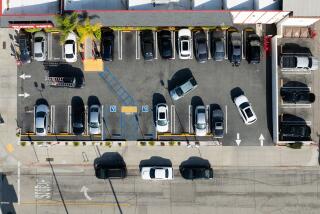Enabling a society that loves its cars
WASHINGTON -- Parking garage connoisseur Shannon Sanders McDonald warms to her subject with a peculiar enthusiasm. Displaying the messianic zeal of someone who champions lost languages or forgotten old-model cars, she laughs a little too early and a little too long at her own jokes. She assumes knowledge in her audience when she shouldn’t, and provides it when she needn’t. Speaking last week at the Library of Congress, McDonald talked about hidden beauty in details few others can see. She also finds beauty where there isn’t any, the perennial danger of being too close to your subject.
McDonald, an architect who recently published “The Parking Garage: Design and Evolution of a Modern Urban Form,” ran through a fascinating slide show: Beginning with glimpses of dead horses, trash and muck on the streets of New York circa 1900, she said the automobile was originally perceived as an environmental boon. Cars were cleaner, and given the occasional epidemic that killed off horses in droves, they were perceived to be more reliable.
The first garages were sometimes converted stables, sometimes other large buildings adapted for new use and sometimes built for the purpose (by auto clubs that worked to defend drivers against the entrenched horse-and-buggy partisans). Early automobiles were not all-weather vehicles -- engines could freeze and exposed leather seats needed special care -- so early garages were heated and protected from the elements. They were, in general, much better integrated into the urban fabric than garages built decades later.
Early in the history of the garage, two philosophical currents emerge. Is the car a machine, to be stored as efficiently as possible? Or is it an extension of our quintessentially American mobility, which often is considered to be almost the same thing as freedom itself? From this split emerged two very different kinds of garages.
The mechanized garage was efficient at housing machines. Drive in, hand the car over to an attendant, and a system of elevators and turntables moved the car to its place. But that lacked the freedom of the other model, the ramp garage, which eventually led to the self-park garage that we are all but addicted to today.
The architecture of the old mechanized garages was generally superior -- more beautiful, exuberant and sensitive -- to that of the ramp garages that replaced them. Before the advent of massive self-park facilities, garages were generally in better proportion to the buildings around them, with floor and roof lines often indistinguishable from office towers or residential buildings. Mechanized garages could be built more vertical, and cars could be stacked higher.
But the freedom, or perceived freedom, of the ramp system eventually won out. As cars became emotionally fused with the very identity of most Americans, turning the car over to an attendant, or having to wait for it to appear at the end of the day, became a nuisance.
And so some of the most fascinating pages of McDonald’s book are devoted to the evolution of ever more sophisticated ramp systems. Ramps waste space: Built too short, they are too steep for most cars; too long, you lose room for parking.
The patented D’Humy ramp system was basically two conjoined garages with staggered floors and shorter ramps, which wasted less space. In 1924, Frank Lloyd Wright designed a strange, spiraling tower for Sugarloaf Mountain in Maryland (a destination for day-trippers from Washington) that included parking on some ramps. It was never built (and other architects were making similar experiments), but eventually Wright’s idea became standard practice.
“I think the Guggenheim occurred because Frank Lloyd Wright never got to build his garage,” said McDonald, referring to Wright’s landmark New York museum, essentially a long, spiraling walkway with room to park art on the sides. Her remark was tossed off as a joke, but it may be a brilliant insight.
But ramp garages are bewildering. You never quite know your relationship to the ground, or to the building you’re about to enter. Your car is always a half-floor above or below you, no matter how carefully you plot your return.
Ramps may store cars efficiently, but they sever an age-old architectural connection between you, the building and the earth you drove in on. And while the grand galleries of old rail stations provided a spiritual sense of transition to the city, the garage is always a nuisance, with no sense of drama, or flow, or grandeur.
With the 1930s, when cars no longer needed to be protected from the elements, garages became more strictly functional and unbelievably ugly: squat, rectilinear buildings with open sides, showing cars like rows of bad teeth. They were often plunked into the urban landscape, breaking up neighborhoods, dwarfing historic buildings, cutting people off from views they once took for granted.
McDonald acknowledges what many people feel -- “the parking garage is a large, imposing, desolate and often stark structure,” she writes -- but she loves these shaggy beasts so much that such caveats are generally lost in a rush of enthusiasm. Some of her favorite garages, especially the early ones, are indeed beauties. McDonald’s passion is not undiscriminating, but it is premised on some things we would be better off questioning. Garages, McDonald argues, are a necessity, essential to our fundamental American right to mobility in an urbanized world. The challenge is to build them better.
Yes, they can be built better than they have been (they can intersect with mass transit, they can be hidden underground or disguised behind better facades). But until the economics of urban land use and the demand for huge amounts of parking change, they can never really be made beautiful. They are almost always too large to be hidden and, rather like funeral parlors, no matter how nice they are on the outside, you always know what’s on the inside.
Should we work toward their obsolescence and elimination (retained only for shared cars, buses, electric vehicles, etc.)? That is a trenchant, hard-nosed but ultimately more rational choice than the blithe acceptance of them as necessary evils that just need a little tweaking. Banishing the garage would force some social engineering on a population that desperately needs to wean itself from a planet-killing addiction to the automobile.
The parking garage is an enabler for an auto-dependent society. McDonald finds beauty in her subject and has some sensible suggestions on improvements. But in a better world, we would enjoy their occasional beauty with nostalgic hindsight, in books as well-researched and illustrated as McDonald’s, or after they’ve been converted to lofts or torn down.






